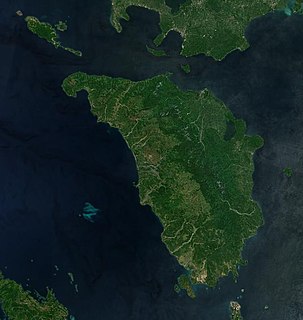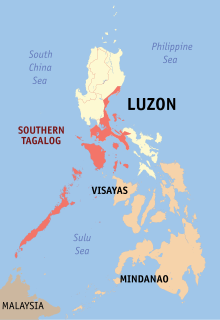Related Research Articles

Mindoro is the seventh largest and eighth-most populous island in the Philippines. With a total land area of 10,571 km2 and has a population of 1,408,454 as of 2020 census. It is located off the southwestern coast of Luzon and northeast of Palawan. Mindoro is divided into two provinces: Occidental Mindoro and Oriental Mindoro. San Jose is the largest settlement on the island with a total population of 143,430 inhabitants as of 2015. The southern coast of Mindoro forms the northeastern extremum of the Sulu Sea. Mount Halcon is the highest point on the island, standing at 8,484 feet (2,586 m) above sea level located in Oriental Mindoro. Mount Baco is the island's second highest mountain with an elevation of 8,163 feet (2,488 m), located in the province of Occidental Mindoro.

Southern Tagalog, designated as Region IV, was an administrative region in the Philippines that comprised the current regions of Calabarzon and Mimaropa, the province of Aurora of Central Luzon, and several cities of Metro Manila. The name remains as a geographical region only, which exempts Aurora.

The Bisayan languages or Visayan languages are a subgroup of the Austronesian languages spoken in the Philippines. They are most closely related to Tagalog and the Bikol languages, all of which are part of the Central Philippine languages. Most Bisayan languages are spoken in the whole Visayas section of the country, but they are also spoken in the southern part of the Bicol Region, islands south of Luzon, such as those that make up Romblon, most of the areas of Mindanao and the province of Sulu located southwest of Mindanao. Some residents of Metro Manila also speak one of the Bisayan languages.
The Central Philippine languages are the most geographically widespread demonstrated group of languages in the Philippines, being spoken in southern Luzon, Visayas, Mindanao, and Sulu. They are also the most populous, including Tagalog, Bikol, and the major Visayan languages Cebuano, Hiligaynon, Waray, Kinaray-a, and Tausug, with some forty languages all together.
Ratagnon is a regional language spoken by the Ratagnon people, an indigenous group from Occidental Mindoro. It is a part of the Bisayan language family and is closely related to other Philippine languages. Its speakers are shifting to Tagalog. In 2000, there were only two to five speakers of the language. However, in 2010 Ethnologue had reported there were 310 new speakers.

Mangyan is the generic name for the eight indigenous groups found on the island of Mindoro, southwest of the island of Luzon, the Philippines, each with its own tribal name, language, and customs. The total population may be around 280,000, but official statistics are difficult to determine under the conditions of remote areas, reclusive tribal groups and some having little if any outside world contact.

The Philippine languages or Philippinic are a proposed group by R. David Paul Zorc (1986) and Robert Blust that include all the languages of the Philippines and northern Sulawesi, Indonesia—except Sama–Bajaw and a few languages of Palawan—and form a subfamily of Austronesian languages. Although the Philippines is near the center of Austronesian expansion from Formosa, there is little linguistic diversity among the approximately 150 Philippine languages, suggesting that earlier diversity has been erased by the spread of the ancestor of the modern Philippine languages.
The Buhid language is a language spoken by Mangyans in the island of Mindoro, Philippines. It is divided into eastern and western dialects.
The Tadyawan language is a language spoken by Mangyans in the southern Lake Naujan in Oriental Mindoro, Philippines.
Hanunoo, or Hanunó'o, is a language spoken by Mangyans in the island of Mindoro, Philippines.
The Alangan language is a language spoken by Mangyans in the province of Mindoro in the Philippines.
The Iraya language is a language spoken by Mangyans on the island of Mindoro in the Philippines. Zorc (1974) places the Iraya language within the North Mangyan group of Malayo-Polynesian languages, though Lobel (2013) notes that it shows "considerable differences" to Tadyawan and Alangan, the other languages in this group. There are 6,000 to 8,000 Iraya speakers, and that number is growing. The language status of Iraya is developing, meaning that this language is being put to use in a strong and healthy manner by its speakers, and it also has its own writing system.

The Central Luzon languages are a group of languages belonging to the Philippine languages. These are predominantly spoken in the western portions of Central Luzon in the Philippines. One of them, Kapampangan, is the major language of the Pampanga-Mount Pinatubo area. However, despite having three to four million speakers, it is threatened by the diaspora of its speakers after the June 1991 eruption of that volcano. Globalization also threatened the language, with the younger generation more on using and speaking Tagalog and English, but promotion and everyday usage boosted the vitality of Kapampangan.
The Southern Mindoro languages are one of two small clusters of Austronesian languages spoken by the Mangyan people of Mindoro Island in the Philippines. They make up a branch of the Greater Central Philippine subgroup.
The Kalamian languages are a small cluster of languages spoken in the Philippines: Calamian Tagbanwa and Agutaynen. Other languages called Tagbanwa, the Aborlan Tagbanwa language and Central Tagbanwa language are members of the Palawanic languages.
The Greater Central Philippine languages are a proposed subgroup of the Austronesian language family, defined by the change of Proto-Malayo-Polynesian *R to *g. They are spoken in the central and southern parts of the Philippines, and in northern Sulawesi, Indonesia. This subgroup was first proposed by Robert Blust (1991) based on lexical and phonological evidence, and is accepted by most specialists in the field.
The Negrito peoples of the Philippines speak various Philippine languages. They have more in common with neighboring languages than with each other, and are listed here merely as an aid to identification.
Old Tagalog, also known as Old Filipino, is the earliest form of the Tagalog language during the Classical period. It is the primary language of pre-colonial Tondo, Namayan and Maynila. The language originated from the Proto-Philippine language and evolved to Classical Tagalog, which was the basis for Modern Tagalog. Old Tagalog uses the Tagalog script or Baybayin, one of the scripts indigenous to the Philippines.
The Proto-Philippine language is a reconstructed ancestral proto-language of the Philippine languages, a proposed subgroup of the Austronesian languages which includes all languages within the Philippines as well as those within the northern portions of Sulawesi in Indonesia. Proto-Philippine is not directly attested to in any written work, but linguistic reconstruction by the comparative method has found regular similarities among languages that cannot be explained by coincidence or word-borrowing.
The Southern Cordilleran languages are a group of closely related languages within the Northern Luzon subgroup of the Austronesian language family. They are spoken in an area stretching from the southern shore of the Lingayen Gulf to the highlands of Quirino province. The most widely spoken Southern Cordilleran language is Pangasinan, one of the eight major languages of the Philippines.
References
- 1 2 Zorc, R. David (1974). "Internal and External Relationships of the Mangyan Languages". Oceanic Linguistics. 13 (1/2): 561–600. doi:10.2307/3622753. JSTOR 3622753.
- ↑ Himes, Ronald S. (2012). "The Central Luzon Group of Languages". Oceanic Linguistics. 51 (2): 490–537. doi:10.1353/ol.2012.0013. JSTOR 23321866. S2CID 143589926.
- ↑ Reid, Lawrence A. (2017). "A Re-evaluation of the position of Iraya among Philippine languages" (PDF). In Liao, Hsiu-chuan (ed.). Issues in Historical Linguistics. JSEALS Special Publication 1. Honolulu: University of Hawai‘i Press. pp. 23–47. hdl:10524/52405.